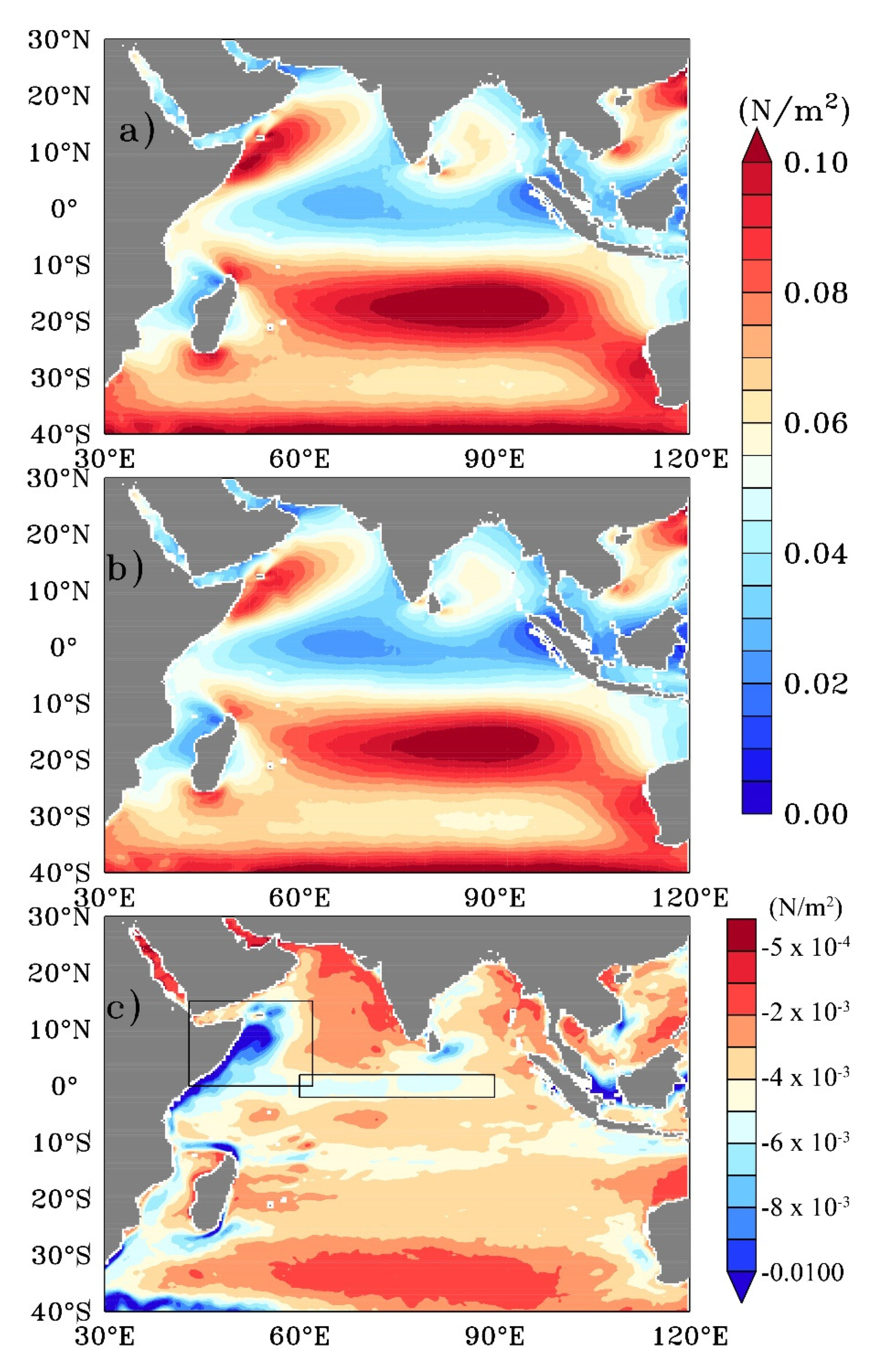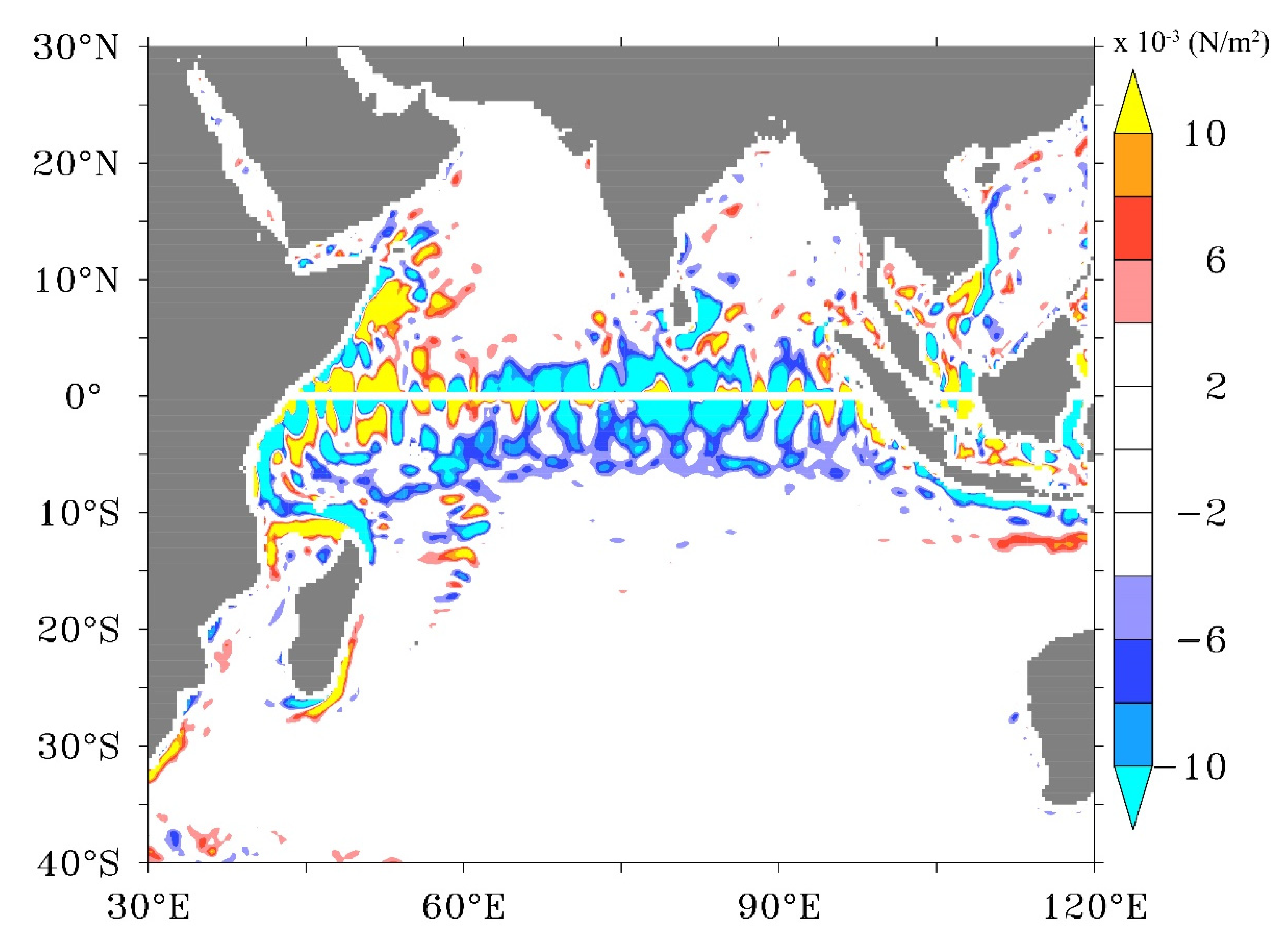Impact of Ocean Currents on Wind Stress in the Tropical Indian Ocean
Abstract
:1. Introduction
2. Materials and Methods
2.1. Data
2.2. Methods
3. Results and Discussions
3.1. Annual Impact
3.2. Zonal and Regional Impact
3.3. Monthly and Seasonal Impact
3.4. Sensitivity Analysis
3.5. Impact on Derived Parameters
4. Conclusions
Author Contributions
Funding
Data Availability Statement
Acknowledgments
Conflicts of Interest
References
- Kraus, E.B. Atmosphere-Ocean Interaction; Oxford University Press: Oxford, UK, 1972; p. 275. [Google Scholar]
- Kelly, K.A.; Dickinson, S.; McPhaden, M.J.; Johnson, G.C. Ocean Currents Evident in Satellite Wind Data. Geophys. Res. Lett. 2001, 28, 2469–2472. [Google Scholar] [CrossRef]
- Bourassa, M.A.; TMeissner, I.; Cerovecki, P.; Chang, X.; Dong, G.; De Chiara, C.; Donlon, D.S.; Dukhovskoy, J.; Elya, A.; Fore, M.R.; et al. Remotely Sensed Winds and Wind Stresses for Marine Forecasting and Ocean Modeling. Front. Mar. Sci. 2019, 6, 443. [Google Scholar] [CrossRef] [Green Version]
- Ali, M.M.; Bhat, G.S.; Long, D.G.; Bharadwaj, S.; Bourassa, M.A. Estimating wind stress at the ocean surface from scatterometer observations. IEEE Geosci. Remote Sens. Lett. 2013, 10, 1129–1132. [Google Scholar] [CrossRef] [Green Version]
- Ali, M.M.; Bourassa, M.A.; Bhowmick, S.A.; Sharma, R.; Niharika, K. Retrieval of wind stress at the ocean surface from Altika Measurements. IEEE Geosci. Remote Sens. Lett. 2016, 13, 821–825. [Google Scholar] [CrossRef]
- Kara, A.B.; Wallcraft, A.J.; Bourassa, M.A. Air-Sea Stability Effects on the 10m Winds Over the Global Ocean: Evaluations of Air-Sea Flux Algorithms. J. Geophys. Res. 2008, 113, C04009. [Google Scholar] [CrossRef] [Green Version]
- Plagge, A.M.; Vandemark, D.; Chapron, B. Examining the impact of surface currents on satellite scatterometer and altimeter ocean winds. J. Atmos. Ocean. Technol. 2012, 29, 1776–1792. [Google Scholar] [CrossRef]
- Ross, D.B.; Overland, J.; Pierson, W.J., Jr.; Cardone, V.J.; McPherson, R.D.; Yu, T.W. Oceanic surface winds. Adv. Geophys. 1985, 27, 101–138. [Google Scholar]
- Liu, W.T.; Tang, W. Equivalent Neutral Wind; JPL Publication 96-17; Jet Propulsion Laboratory: Pasadena, CA, USA, 1996; p. 16. [Google Scholar]
- Pacanowski, R.C. Effect of equatorial currents on surface stress. J. Phys. Oceanogr. 1987, 17, 833–838. [Google Scholar] [CrossRef]
- Dave, J.T.; Thompson, J. Effect of ocean surface currents on wind stress, heat flux, and wind power input to the ocean. Geophys. Res. Lett. 2006, 33, L09604. [Google Scholar] [CrossRef] [Green Version]
- Luo, J.J.; Masson, S.; Roeckner, E.; Madec, G.; Yamagata, T. Reducing climatology bias in an ocean-atmosphere CGCM with improved coupling physics. J. Clim. 2005, 18, 2344–2360. [Google Scholar] [CrossRef]
- Kloe, J.D.; Stoffelen, A.; Verhoef, A. Improved use of scatterometer measurements by using stress-equivalent reference winds. IEEE JSTARS 2017, 10, 2340–2347. [Google Scholar] [CrossRef]
- Seo, H.; Subramanian, A.C.; Song, H.; Chowdary, J.S. Coupled effects of ocean current on wind stress in the Bay of Bengal: Eddy energetics and upper ocean stratification. Deep.-Sea Res. II 2019, 168, 104617. [Google Scholar] [CrossRef]
- Shi, Q.; Bourassa, M.A. Coupling ocean currents and waves with wind tress over the Gulf Stream. Remote Sens. 2019, 11, 1476. [Google Scholar] [CrossRef] [Green Version]
- Song, H.; Marshall, J.; McGillicuddy, D.J.; Seo, H. Impact of current-wind interaction on vertical processes in the Southern Ocean. J. Geophys. Res. Ocean. 2020, 125, e2020JC016046. [Google Scholar] [CrossRef]
- Renault, L.; Molemaker, M.J.; McWilliams, J.C.; Schepetkin, A.F.; Lemarié, F.; Chelton, D.; Illig, S.; Hall, A. Modulation of wind work by oceanic current interaction with the atmosphere. J. Phys. Oceanogr. 2016, 46, 1685–1704. [Google Scholar] [CrossRef]
- Duhaut, T.H.A.; Straub, D.N. Wind stress dependence on ocean surface velocity: Implications for mechanical energy input to ocean circulation. J. Phys. Oceanogr. 2006, 36, 202–211. [Google Scholar] [CrossRef]
- O’Neill, L.W.; Chelton, D.B.; Esbensen, S.K. Covariability of surface wind and stress responses to sea surface temperature fronts. J. Clim. 2012, 25, 5916–5942. [Google Scholar] [CrossRef] [Green Version]
- Chelton, D.; Schlax, M.G.; Freilich, M.H.; Milliff, R.F. Satellite measurements reveal persistent small-scale features in ocean winds. Science 2004, 303, 978–983. [Google Scholar] [CrossRef] [Green Version]
- Shankar, D.; Vinayachandran, P.N.; Unnikrishnan, A.S. The monsoon currents in the north Indian Ocean. Prog. Oceanogr. 2002, 52, 63–120. [Google Scholar] [CrossRef]
- Shenoi, S.S.C.; Saji, P.K.; Almeida, A.M. Near-surface circulation and kinetic energy in the tropical Indian Ocean derived from Lagrangian drifters. J. Mar. Res. 1999, 57, 885–907. [Google Scholar] [CrossRef]
- Schott, F.A.; McCreary, J.P. The monsoon circulation of the Indian Ocean. Prog. Oceanogr. 2001, 51, 1–123. [Google Scholar] [CrossRef]
- Schott, F. Monsoon response of the Somali Current and associated upwelling. Prog. Oceanogr. 1993, 12, 357–381. [Google Scholar] [CrossRef]
- Swallow, J.C.; Bruce, J.G. Current measurements off the Somali Coast during southwest monsoon of 1964. Deep. -Sea Res. 1966, 13, 861–888. [Google Scholar] [CrossRef]
- Wyrtki, K. An equatorial jet in the Indian Ocean. Science 1973, 181, 262–264. [Google Scholar] [CrossRef]
- Seo, H.; Miller, A.J.; Norris, J.R. Eddy-wind interaction in the California Current System: Dynamics and impacts. J. Phys. Oceanogr. 2016, 46, 439–459. [Google Scholar] [CrossRef]
- Seo, H. Distinct Influence of Air–Sea Interactions Mediated by Mesoscale Sea Surface Temperature and Surface Current in the Arabian Sea. J. Clim. 2017, 30, 8062. [Google Scholar] [CrossRef] [Green Version]
- Bentamy, A.; Denis, C.F. Gridded surface wind fields from Metop/ASCAT measurements. Int. J. Remote Sens. 2012, 33, 1729–1754. [Google Scholar] [CrossRef] [Green Version]
- Bonjean, F.; Lagerloef, G.S.E. Diagnostic model and analysis of the surface currents in the tropical Pacific Ocean. J. Phys. Oceanogr. 2002, 32, 2938–2954. [Google Scholar] [CrossRef]







| Region of Interest | τno-Cur (N/m2) | τCur (N/m2) | τCur − τno-Cur (N/m2) | % Difference |
|---|---|---|---|---|
| Basin Average | 0.06448 | 0.06073 | −0.00282 | −5.81% |
| Somali Current (43° E–64° E; 0–15° N) region | 0.06264 | 0.05665 | −0.00599 | −9.56% |
| Equatorial Jet (60° E–90° E; 2° S–2° N) region | 0.03145 | 0.02644 | −0.00501 | −15.93% |
| Season | EXP1_W10 | EXP1_W5 | NOEXP | EXP2_C5 | EXP2_C10 |
|---|---|---|---|---|---|
| Basin Averaged | |||||
| March–April–May | −5.279% | −5.526% | −5.798% | −6% | −11.2% |
| June–September | −4.88% | −5.508% | −5.3318% | −5.59% | −9.83% |
| October–November | −5.71% | −5.98% | −6.28% | −6.562% | −15.4% |
| December–January–February | −5.896% | −6.159% | −6.611% | −6.755% | −9.8% |
| Off Somali Coast | |||||
| March–April– –May | −16.11% | −16.8% | −17% | −18.43% | −19.22% |
| June–September | −12.04% | −12.55% | −13.15% | −13.76% | −14.39% |
| October–November | −15.46% | −16.1% | −16.9 | −17.6% | −18.45% |
| December–January–February | −16.48% | −17.2% | −18 | −18.85% | −19.669% |
| Equatorial Region | |||||
| March–April–May | −9.357% | −9.78% | −10.24% | −10.7% | −11.22% |
| June–September | −8.155% | −8.6% | −8.9% | −9.4% | −9.9% |
| October–November | −13.01% | −13.59% | −14.18% | −14.83% | −15.484% |
| December–January–February | −8.2% | −8.60% | −8.9% | −9.4% | −9.8% |
| Parameter | Without Current | With Current | % Difference |
|---|---|---|---|
| Ekman Currents (m/s) | 0.1130 | 0.1050 | −5.46 |
| Wind Power input (W/m2) | 0.01110 | 0.00998 | −10.0631 |
Publisher’s Note: MDPI stays neutral with regard to jurisdictional claims in published maps and institutional affiliations. |
© 2022 by the authors. Licensee MDPI, Basel, Switzerland. This article is an open access article distributed under the terms and conditions of the Creative Commons Attribution (CC BY) license (https://creativecommons.org/licenses/by/4.0/).
Share and Cite
Chacko, N.; Ali, M.M.; Bourassa, M.A. Impact of Ocean Currents on Wind Stress in the Tropical Indian Ocean. Remote Sens. 2022, 14, 1547. https://doi.org/10.3390/rs14071547
Chacko N, Ali MM, Bourassa MA. Impact of Ocean Currents on Wind Stress in the Tropical Indian Ocean. Remote Sensing. 2022; 14(7):1547. https://doi.org/10.3390/rs14071547
Chicago/Turabian StyleChacko, Neethu, Meer M. Ali, and Mark A. Bourassa. 2022. "Impact of Ocean Currents on Wind Stress in the Tropical Indian Ocean" Remote Sensing 14, no. 7: 1547. https://doi.org/10.3390/rs14071547
APA StyleChacko, N., Ali, M. M., & Bourassa, M. A. (2022). Impact of Ocean Currents on Wind Stress in the Tropical Indian Ocean. Remote Sensing, 14(7), 1547. https://doi.org/10.3390/rs14071547








